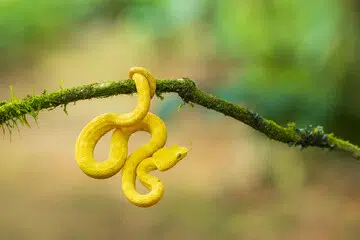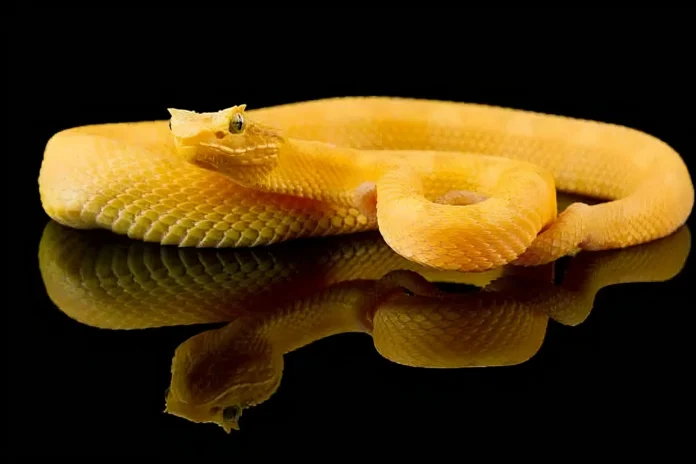Table of Contents
Scientific Classification
| Kingdom | Animalia |
| Phylum | Chordata |
| Class | Reptilia |
| Order | Squamata |
| Family | Viperidae |
| Genus | Bothriechis |
| Species | Bothriechis schlegelii |
| Scientific Name | Bothriechis schlegelii |
1. Description
The eyelash viper (Bothriechis schlegelii) seems like it stepped right out of a fantasy tale. This small snake is not only stunning but also venomous, making it a fascinating creature found in Central and South America. Its common name comes from the unique scales that sit above its eyes, resembling thick, curling eyelashes. These “eyelashes” aren’t just for show; they play a vital role in helping the snake blend into its environment.
Typically, eyelash vipers measure between 20 to 30 inches long (50 to 75 cm), with females generally being larger than males. They sport stout bodies, broad triangular heads, and striking vertical pupils that resemble those of a cat. What truly sets this species apart is its vibrant coloration. They can be bright yellow, often referred to as the “oropel” morph, or come in shades of green, pink, red, brown, and even a mix of these hues.
This colorful appearance allows them to seamlessly merge with their surroundings, whether they’re lounging on a mossy branch or coiling among orchids.
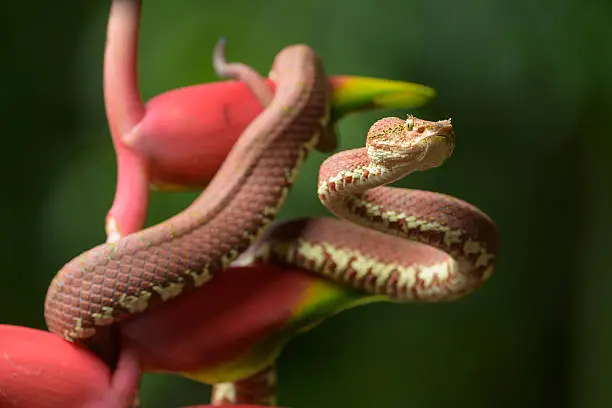
2. Distribution
Eyelash vipers can be found mainly in Central and northern South America. Their habitat stretches across:
– Southern Mexico
– Guatemala
– Honduras
– Nicaragua
– Costa Rica
– Panama
They even reach into Colombia, Ecuador, and northern Peru. These snakes tend to thrive in humid, lush environments, particularly along the Caribbean and Pacific slopes.
3. Habitat
The eyelash viper thrives in tropical rainforests and lush, lowland moist forests. These fascinating snakes prefer to spend most of their time high up in the trees, rarely venturing down to the forest floor.
They’re particularly drawn to:
– Dense foliage
– Flowering plants
– Tree hollows
Branches that are close to fruiting or flowering trees are especially appealing, as they attract birds and frogs, which make up their main diet.
You can often find eyelash vipers in cloud forests and lower montane forests, where the humidity and cover provide a perfect environment for them. They tend to shy away from dry, open areas and are quite sensitive to changes in their habitat, such as deforestation.
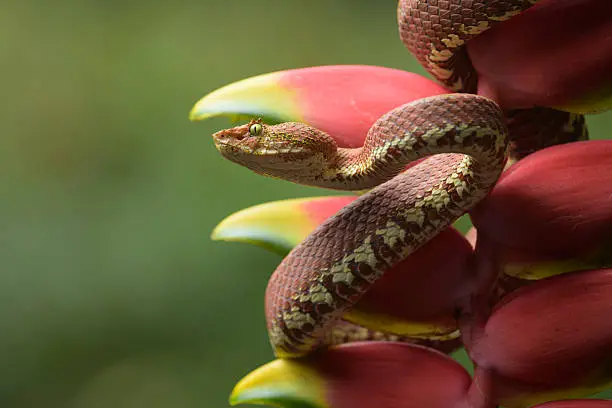
4. Diet
When it comes to hunting, eyelash vipers are the ultimate ambush predators. They have a knack for being incredibly patient, often remaining perfectly still for long stretches of time. Their incredible camouflage allows them to blend seamlessly into their surroundings, making it easy to avoid detection while they wait for unsuspecting prey to wander too close.
These fascinating snakes have quite the menu, which includes:
– Small birds
– Rodents
– Lizards
– Frogs and other amphibians
– Bats
Equipped with long, hinged fangs, they can deliver a potent hemotoxic venom that quickly immobilizes their prey and begins the digestion process. Once they’ve struck, they swallow their meal whole, starting with the head to make it easier to gulp down.
Juvenile eyelash vipers tend to stick to smaller snacks like frogs and tiny lizards until they grow big enough to tackle larger meals.
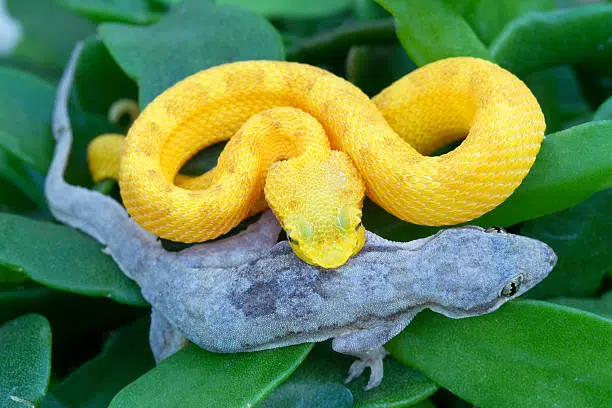
5. Behavior
Eyelash vipers are quite the solitary creatures. They usually prefer the cover of night, but if you’re lucky, you might catch a glimpse of them during the day, especially in overcast or shady spots. Generally, they’re not aggressive unless they feel threatened or are handled.
Here are some key behaviors to note:
– They excel at ambush hunting.
– They can stay completely still for hours or even days.
– They move through trees using their strong, muscular coils.
– They flick their tongues to pick up scents from their surroundings.
Despite being venomous, eyelash vipers aren’t considered a significant threat to humans. This is largely because they tend to keep to themselves and avoid confrontation whenever possible.
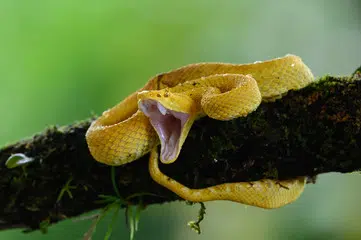
6. Lifespan
In the wild, eyelash vipers typically have a lifespan of around 10 to 12 years. However, this can change based on various factors like their environment, the presence of predators, and the availability of food.
When kept in captivity, with proper care and regular feeding, they can live anywhere from 15 to 20 years. That said, reaching this longer lifespan is quite uncommon unless they’re under professional care.
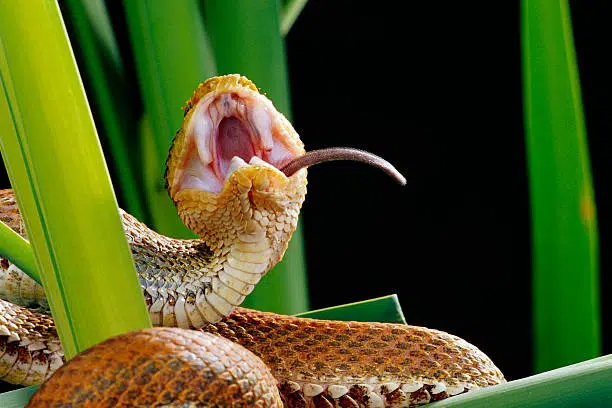
7. Reproduction and Lifecycle
Eyelash vipers have a fascinating way of reproducing; they are ovoviviparous. This means instead of laying eggs, they give birth to live young. The fertilized eggs actually develop inside the mother’s body and hatch there.
After mating, the female carries her developing embryos for about six months. When the time comes, she gives birth to anywhere from 5 to 20 fully formed neonates, each measuring between 6 to 8 inches long.
These young snakes are born ready to fend for themselves and are venomous right from the start. They can hunt and take care of their own needs without any help from their parents. Their survival relies entirely on their instincts and their ability to blend into their surroundings.
8. Predators
The eyelash viper is quite the adept hunter, but it faces its fair share of dangers in the wild.
Its predators include:
– Large birds of prey, like hawks and eagles
– Carnivorous mammals, such as coatis and wild cats
– Occasionally, larger snakes
However, the most significant threat to these snakes doesn’t come from other animals. It’s actually human activity, particularly habitat destruction.
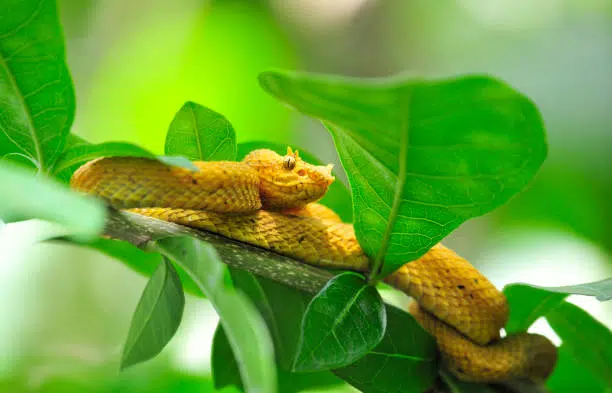
9. Adaptations
Eyelash vipers have some pretty amazing adaptations that help them thrive in the wild:
Camouflage: Their color morphs blend seamlessly with the lush tropical plants around them.
Eyelash-like scales: These unique scales break up the outline of the snake’s head, making it even harder to spot.
Heat-sensing pits: Located between the nostril and the eye, these pits can pick up on infrared radiation from warm-blooded prey.
Prehensile tail: This tail allows them to move nimbly among branches.
Ambush strategy: This tactic helps them save energy while boosting their chances of a successful strike.
Each of these adaptations plays a crucial role in the viper’s survival in dense forests.
10. Nest
Unlike many snakes that build or protect nests, eyelash vipers take a different approach—they don’t use nests at all. Instead, the female is ovoviviparous, meaning she carries her developing young inside her body.
Once they’re born, the little ones quickly disperse into their surroundings. They find refuge in leaf litter, small shrubs, or low branches. Their natural camouflage plays a crucial role in keeping them safe from predators.
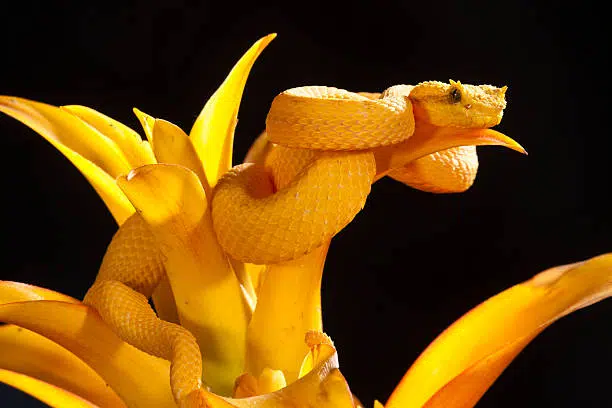
11. Mating Season
The eyelash viper mates during the rainy season. This season changes a bit depending on the area but usually runs from May to August.
During this time, males seek out females using pheromone trails. Males can take part in combat dances. These are ritual shows of strength. They aim to show dominance and win mating rights.
12. Breeding
When a male finds a receptive female, he courts her with soft body contact and alignment. Mating can last several hours. After mating, the male leaves. The female then carries the embryos inside her for several months.
Breeding frequency can change. However, females usually reproduce every two years. This depends on food availability and how stable the environment is.
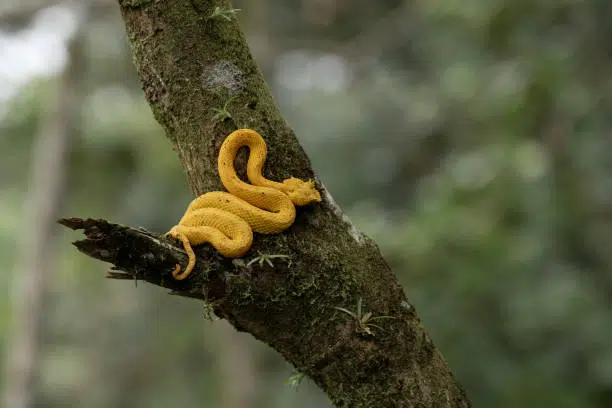
13. Interesting Facts
- Did you know that “Oropel” morphs, or golden-yellow eyelash vipers, are a favorite among wildlife photographers thanks to their stunning colors?
- These fascinating creatures are known as “eyelash palm-pit vipers” because of their unique habitat and the sensory pits they possess.
- While eyelash vipers are venomous, their bites are rarely fatal to humans. In fact, bites are quite uncommon, and if they do occur, antivenom is readily available.
- What’s really cool is that their infrared-sensing pits give them a sort of sixth sense, allowing them to detect warm-blooded prey even in total darkness.
- Although they can be dangerous, eyelash vipers often find themselves caught up in the exotic pet trade. It’s generally discouraged to keep them as pets due to their venom and their important role in the ecosystem.
- Interestingly, each neonate is born venomous, but their venom is not as potent as that of adult vipers.
14. Conservation Status
The eyelash viper is currently classified as a species of Least Concern by the IUCN. However, this does not mean they are free from threats. Their populations are believed to be declining locally due to:
- Habitat destruction from agriculture and logging
- Fragmentation of forest habitats
- Illegal pet trade
- Road mortality in forest-edge areas
Deforestation in Central and South America is still common. But it could seriously harm their populations in the future.
To protect this important species, we must save tropical rainforests. We also need to enforce anti-poaching laws and control the pet trade.
Conclusion
The eyelash viper shows nature’s artistry. It’s both beautiful and deadly. Its elegant lashes, strong venom, and secret jungle life highlight the rich biodiversity of the tropical Americas.
The story tells us that creatures we see as safe today may be in danger tomorrow if their homes are lost or disturbed. Protecting species like the eyelash viper helps keep the complex web of life safe. They play an important role in this system.
